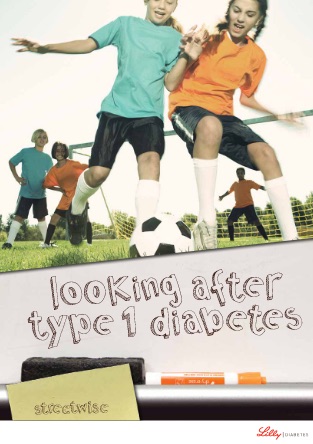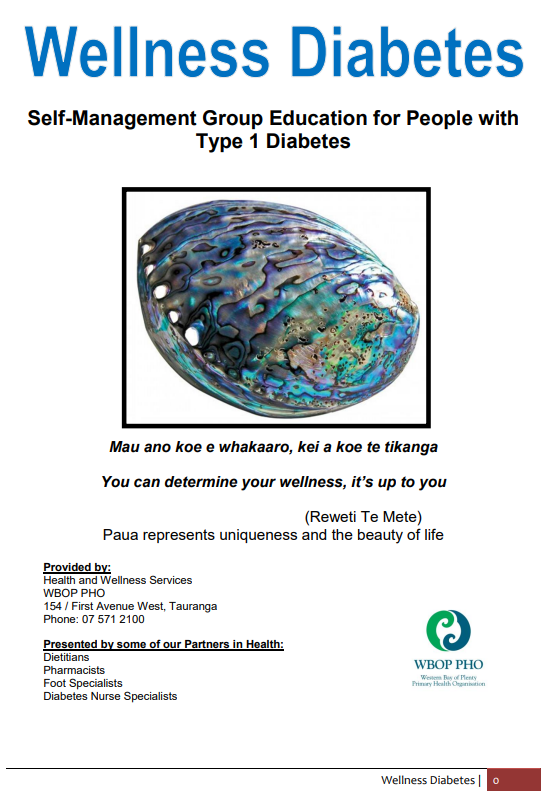Wishing everyone happy holidays and a joyful New Year from the Healthify team. Don't forget to Slip, Slop, Slap and Wrap!
Diabetes – type 1 | Mate huka momo tuatahi
Previously known as insulin-dependent diabetes mellitus or juvenile diabetes
Key points about diabetes type 1
- Type 1 diabetes (mate huka kai rongoā taiaki) is a condition that causes the level of glucose (a type of sugar) in your blood to become too high.
- It happens when your body is not able to produce enough of a hormone called insulin, which controls blood glucose.
- Type 1 diabetes is mainly diagnosed in childhood and is not caused by being overweight or eating sweet foods.
- It is different to type 2 diabetes.
- You need daily injections of insulin to keep your blood glucose levels under control.
- Managing type 1 diabetes can take some getting used to, but should not stop you from leading a full and active life.

Type 1 diabetes is a condition that causes the level of glucose (a type of sugar) in your blood to become too high. It happens when your body isn't able to produce enough of a hormone called insulin, which controls blood glucose. If you have type 1 diabetes, you'll need daily injections of insulin to keep your blood glucose levels under control.
Type 1 diabetes is mainly diagnosed in childhood and isn't caused by being overweight or eating sweet foods.
It's different to type 2 diabetes.
Managing type 1 diabetes can take some getting used to, but shouldn't stop you from leading a full and active life.
Type 1 diabetes is an auto-immune disease. Your body's immune system, which normally protects you from infection, attacks the insulin-making cells (beta cells) in your pancreas. This causes a decrease in insulin production. Type 1 diabetes can be genetic (run in the family). Read more about insulin deficiency and type 1 diabetes below.
Symptoms of diabetes don't occur until more than 90% of the beta cells have been destroyed. This means that it is difficult to tell that you are developing diabetes until the symptoms of diabetes occur.
Did you know?
- Diabetes can't be caught from another person – it's not contagious.
- Type 1 diabetes isn't caused by eating too much sugar or any other foods.
- There's nothing you could have done differently to prevent yourself or your child from getting type 1 diabetes.
- You can't grow out of type 1 diabetes and it doesn't change into type 2 diabetes as you get older.
The symptoms of type 1 diabetes are caused by high blood glucose levels (hyperglycaemia) and can come on very quickly. People can get quite sick when they first get type 1 diabetes and often need to be in hospital for a few days.
Symptoms can include:
- feeling very thirsty and drinking lots
- having to pee/mimi a lot more than normal (bedwetting in children who didn't previously)
- tiredness
- rapid weight loss
- sores that don't heal
- recurring infections
- poor concentration and performance
- sore tummy/puku which is common in children.
If a diagnosis isn't made quickly, severe dehydration can occur.
If you or your child have any of the above signs and symptoms, and you are concerned, please go to your family doctor or health professional for advice. If you can’t see a doctor for whatever reason, go to the nearest emergency department.
A blood test is used to diagnose diabetes.
Types of blood tests used to diagnose diabetes
- Random blood glucose level: This blood test for the level of glucose in your blood can diagnose diabetes, but the result depends on what food you have eaten before the test.
- HbA1c: This blood test measures the amount of glucose that has accumulated in your blood over a 3-month period. A high HbA1c result confirms the diagnosis of diabetes.
- Fasting blood glucose: This is a measure of how much glucose is in your blood when you have not eaten anything for the past 8–10 hours.
This table shows the ranges of these measures of blood glucose for people without diabetes, with pre-diabetes or with diabetes.
|
|
Normal |
Pre-diabetes |
Diabetes |
|
Random glucose |
≥ 11.1 mmol/l |
||
|
HbA1c |
≤ 40 mmol/mol |
41–49 mmol/mol |
≥ 50 mmol/mol |
|
Fasting blood glucose |
|
6.1–6.9 mmol/l |
≥ 7.0 mmol/l |
Sometimes your healthcare provider may do a urine test to look for sugar or ketones (see Insulin deficiency, below) in your urine. This is a simple test and the results are available immediately but a urine test is not accurate enough to be used to diagnose or rule out diabetes all the time.
Type 1 diabetes is a lifelong condition that can be well managed and controlled with the use of artificial insulin. This insulin is used to replace the insulin that your body can't make. Insulin is taken by an injection just under the skin, not into a vein, with a short, fine needle. It's common to feel anxious at the thought of an injection, but the needle used means that insulin injections are more comfortable than a finger prick. If you need to inject insulin you will be given training and support to manage your treatment.
The aim of treatment is to give the right amount of insulin to balance what you eat with how much energy you need throughout the day. You will feel better and have more energy once you're receiving the right amount of insulin.
Successful management of type 1 diabetes involves:
- regularly testing your blood glucose level throughout the day
- taking regular injections of insulin 2 or more times per day
- eating regular meals and choosing healthy food
- keeping physically active to keep your heart and blood vessels healthy
- learning how to fine-tune your insulin doses with different meal sizes and activity levels.
Learn more about insulin.
Diabetes is a lifelong condition. If it's poorly managed and blood glucose levels aren't controlled, diabetes increases the risk of serious complications such as problems with vision or blindness, heart attack or stroke, kidney failure, circulatory problems and impotence in men.
With good control of your diabetes, many of these complications can be prevented or slowed down.
Long-term risks and complications can be minimised by:
- learning as much as you can about diabetes
- having good medical care – make sure to have your regular check-ups with your doctor or nurse so that potential problems can be found and treated early
- having a healthy food plan and a regular intake of carbohydrates both for growth and development and to balance insulin and activity levels
- getting regular exercise and understanding how physical activity affects blood glucose levels
- watching your cholesterol and blood pressure
- generally having a healthy lifestyle.
Managing low blood glucose (hypoglycaemia)
Although people with type 1 diabetes are trying to keep their blood glucose level from going too high, it's also important to stop it going too low (hypoglycaemia). This can happen when too much insulin is injected or not enough of the right food is eaten at the right time.
Symptoms of hypoglycaemia include sweating, shakiness and light-headedness, and can lead to unconsciousness if not treated. Low blood glucose must be raised urgently, with quick-acting carbohydrate such as glucose tablets (or glucagon injections if the person is unconscious).
Blood glucose testing
To test your blood glucose level throughout the day, you use a small finger prick test to get a drop of blood to put onto a testing strip. The testing strip is inserted into a blood glucose meter and gives a result within seconds. Read more about blood glucose testing for type 1 diabetes.
- A normal reading is between 4–7 mmol/L (glucose is measured in millimoles per litre of blood).
- Check with your doctor, nurse or pharmacist what your target level should be.
- If the level is below 4 mmol/L, you will usually need to eat something.
- If the level is above 7 mmol/L, you may need to alter your insulin dose or do something active.
- Learning how to balance these levels with what you eat, how much insulin you give yourself and your activity levels are the key to managing your diabetes.
- For some people, blood glucose monitoring with a continuous glucose monitoring device may be an option. However this is not currently funded in Aotearoa New Zealand. Read more about continuous glucose monitoring(external link).
Healthy eating and exercise
What you eat and how much exercise you do affects your blood glucose levels. The more you eat and the less you exercise, the higher your blood-glucose levels will be and the more insulin you will need. Learning how to fine-tune your insulin doses with different meal sizes and activity levels is part of managing type 1 diabetes.
To help give you more even blood glucose levels:
- Eat breakfast, lunch and dinner at regular times of the day, with snacks in between as advised by your dietitian or nurse.
- Eat healthy, balanced meals with a range of carbohydrates, fats and protein. Read more about healthy eating.
- Choose high fibre carbohydrates, eg, wholegrain breads (breads with lots of grainy bits), high-fibre breakfast cereals, legumes, fruit and vegetables and those with a low glycaemic index (GI). Carbohydrate foods with a low GI are digested (broken down to glucose) more slowly.
- Exercise regularly.
Stress management and illness with diabetes
Managing stress is especially important. Blood glucose levels are more difficult to control if you are under stress, so you may need to monitor them more frequently.
- Make sure you know what to do when unwell and have a ‘sick day’ plan.
- If you are vomiting or have diarrhoea, see a doctor as you are at higher risk of becoming dehydrated.
Read more about diabetes and sick day planning.
Apps reviewed by Healthify
You may find it useful to look at some Diabetes apps.
Insulin is a hormone that acts as a ‘key’ to move glucose from your blood into your body’s cells where it is used for energy. After you eat, glucose from your food is absorbed through the lining of your stomach into your blood, which increases the glucose levels in your blood.
If you don't have diabetes, your body responds to this increase in glucose by releasing insulin from your pancreas. The insulin helps move the extra glucose from your blood into your cells. Blood-glucose levels return to normal.
With type 1 diabetes, your pancreas makes little or no insulin, so glucose stays in your blood. This means your blood glucose levels stay high – known as hyperglycaemia. Also, your cells don't get the glucose they need for energy, so they use fats to provide energy instead. If your body uses fat for energy too often, it can lead to a dangerous build-up of waste products called ketones.
Some parts of your body, in particular your brain and red blood cells, need some glucose to function properly.
What are ketones and why are they a problem?
Ketones are a type of acid that is produced when your body burns fat for energy instead of glucose. Using fat for energy some of the time is normal. However, if it goes on for too long it can produce high levels of ketones in your blood. This can be dangerous as it can lead to coma or even death.
Treating type 1 diabetes means replacing insulin to ‘unlock’ your cells, letting glucose in and keeping your blood glucose level stable. Successful management of type 1 diabetes involves having insulin injections and balancing what you eat with how active you are each day.
Read more about insulin.
Video: Ramadan: Preparing and Participating if you live with diabetes feat, Lived Experiences
This video may take a few moments to load.
(Diabetes UK, 2012)
Video: "Overwhelmed" Vince Harder & Abby Lee (Official Music Video)
This video may take a few moments to load.
(Vince Harder, Abby Lee and Diabetes NZ, 2021)
It can take time to get used to managing diabetes, but you can still do all the things you enjoy and live a fulfilling life. Working with healthcare providers, diabetes support groups and diabetes educators will help you get a clear understanding of diabetes so you know how to manage best day-today. Ask your healthcare provider or local branch of Diabetes NZ for information about courses or support groups in your area.
Diabetes NZ(external link) is a national organisation with regional branches(external link) and youth support groups.(external link)
Some of the main centre links are provided below:
There is a wealth of information now about living well with diabetes. Be aware that websites from other countries may have information that differs from New Zealand recommendations.
Kiwis living well with diabetes(external link) Diabetes NZ
Diabetes in children(external link) KidsHealth NZ
Living well with diabetes(external link) Diabetes NZ
Navigating airport security screening(external link) Aviation Security Service New Zealand and Diabetes New Zealand
Type 1 diabetes(external link) NHS, UK
Diabetes Foundation Aotearoa(external link)
Apps
References
- Insulin and type 1 diabetes(external link) Diabetes NZ
- Diabetes in children(external link) KidsHealth, NZ
Brochures

Starship NZ

Waikato Bay of Plenty Primary Healthcare Organisation, NZ
Credits: Healthify editorial team. Healthify is brought to you by Health Navigator Charitable Trust.
Reviewed by: Claire Salter, Pharmacist, Tauranga
Last reviewed:
Page last updated:






